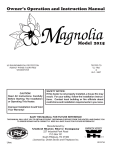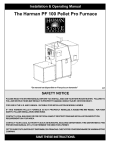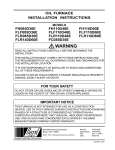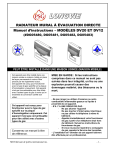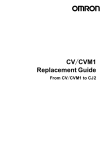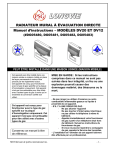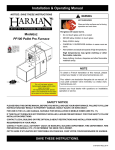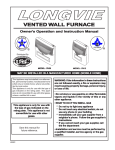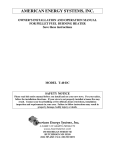Download United States Stove DV12 Instruction manual
Transcript
LONGVIE VENTED WALL FURNACE Owner’s Operation and Instruction Manual Distributed By: MODEL: DV20 MODEL: DV12 MAY BE INSTALLED IN A MANUFACTURED HOME (MOBILE HOME) This Appliance may be installed in an aftermarket, permanently located, manufactured home (USA only) or mobile home, where not prohibited by local codes. This appliance is only for use with the type of gas indicated on the rating plate. This appliance is not convertible for use with other gases, unless a certified kit is used. This appliance is only for use with the type of gas indicated on the rating plate. This appliance is not convertible for use with other gases. Save this manual for future reference. USSC WARNING: If the information in these instructions are not followed exactly, a fire or explosion may result causing property damage, personal injury, or loss of life. ~Do not store or use gasoline or other flammable vapors and liquids in the vicinity of this or any other appliance. ~WHAT TO DO IF YOU SMELL GAS * Do not try to light any appliance * Do not touch any electrical switch; do not use any phone in your building * Immediately call your gas supplier from a neighbor's phone. Follow the gas supplier's instructions * If you cannot reach your gas supplier, call the fire department ~Installation and service must be performed by a qualified installer, service agency or the gas supplier. 1 INTRODUCTION Your LONGVIE heater is especially designed to provide maximum comfort to you and your home. Its large solid injected aluminum front grill assures the optimum use of the generated heat in the ambient, maintains normal temperatures behind the heater to avoid sticking of particles, which would soil the wall. You can feel safe with absolute security guaranteed by: • Its thermocouple security valve, which cuts the supply of gas in the event of the heater extinguishing due to strong air currents, momentary interruption of the supply of gas. • Its gas pressure regulator assures an optimum operational; function, avoiding peak pressures in the gas supply affecting normal combustion. • Its gas tight combustion chamber, totally enameled, avoids gases which are caused by combustion, to contaminate the air and ensures a useful , long lasting working life. Long lasting working life...Guaranteed by the quality of its components and high technology applied in the process of fabrication, and especially by the traditional vocation of LONGVIE to produce durable products for your maximum comfort and satisfaction. LOCAL CODES Install and use the heater with care. The installation must conform with local codes or in the absence of local codes, use the latest edition of The National Fuel Gas Code ANSI Z223.1/NFPA 54*. Natural Gas and Propane Installation Code, CSA B149.1. A manufactured home (USA only) or mobile home OEM installation must conform with the Manufactured Home Construction and Safety Standard, Title 24 CFR, Part 3280, or, when such a standard is not applicable, the Standard for Manufactured Home Installation, ANSI Z225.1, or Standard for Gas Equipped recreational Vehicles and Mobile Housing, CSA Z240.4. *Available from: American National Standards Institute, Inc. 1430 Broadway New York, NY 10018 National Fire Protection Association, Inc. Batterymarch Park Quincy, MA 02269 GAS SPECIFICATIONS MODEL FUEL MAXIMUM INPUT DV12 Natural 10,000 BTU/hr Liquid Propane 10,000 BTU/hr Natural 18,000 BTU/hr Liquid Propane 18,000 BTU/hr DV20 MANIFOLD PRESSURE Natural Gas - DV12 - 5.8” w.c. DV20 - 5.2” w.c. Propane / LP Gas - DV12 - 10.8” w.c. GAS INLET SUPPLY DV20 - 10.6” w.c. 3/8” NPT MIN. PRESSURE MAX. PRESSURE Natural 7” W.C.P. 10.5” W.C.P. Propane / LP 11.0” W.C.P. 13.0” W.C.P. USE ONLY THE TYPE GAS SPECIFIED ON THE RATING PLATE 2 USSC SAFETY RULES 1. Due to high temperatures, the appliance should located out of traffic and away from furniture and draperies. 2. Children and adults should be alerted to the hazards of high surface temperatures and should stay away to avoid burns or clothing ignition. 3. Young children should be carefully supervised when they are in the same room as the appliance 4. Clothing or other flammable material should not be placed on or near the appliance. 5. Any safety screen or guard removed for servicing an appliance must be replaced prior to operating the appliance. 6. Installation and repair should be done by a qualified service person. The appliance should be inspected before use and at least annually by a qualified service person. More frequent cleaning may be necessary due to excessive lint from carpeting, bedding material, etc. It is imperative that control compartments, burners and circulating air passageways of the appliance be kept clean. 7. WARNING: Do not operate appliance with the panel removed, cracked or broken. Replacement of the panel should be done by a licensed or qualified service person. 8. Do not spray any aerosol near heater when functioning. Do not store these elements near appliance. 9. Do not touch the grill to avoid burning yourself. 10. Do not touch the gases outlet cap while heater is in operation to avoid burning yourself. 11. Avoid blocking air inlet and hot air outlet. 12. Do not spill water over the heater as it may cause corrosion. 13. Allow heater to thoroughly cool before servicing. 14. Input ratings are shown in BTU per hour and are for elevations up to 2,000 feet. For elevations above 2,000 feet, input ratings should be reduced 4 percent for each 1,000 feet above see level. Refer to the National Fuel Gas Code. 15. The appliance and its appliance main gas valve must be disconnected from the gas supply piping system during any pressure testing of that system at test pressures in excess of 1/2 psig (3.5 kPa). 16. The appliance must be isolated from the gas supply piping system be closing its equipment shutoff valve during any pressure testing of the gas supply piping system at test pressures equal to or less than 1/2 psig (3.5 kPa). 17. This gas appliance must not be connected to a chimney flue serving a separate solid-fuel burning appliance. 18. The installation make provisions for adequate combustion and ventilation air. 19. The installation must provide adequate accessibility clearances for servicing. 20. The efficiency rating of this appliance is a product thermal efficiency rating determined under continuous operating conditions and was determined independently of any installed system. 21. The minimum inlet gas supply for the purpose of input adjustment. 22. Do not use this appliance if any part has been under water. Immediately call a qualified service technician to inspect the appliance and to replace any part of the control system and any gas control that has been under water. USSC 3 MINIMUM CLEARANCES TO COMBUSTIBLES Rear Sides Top Floor 0 Inches / 0mm (to bracket) 6 Inches / 15cm 24 Inches / 61cm 7 Inches / 18cm (to top of carpeting, tile, etc.) Diagram Nº 1 INSTALLATION INSTRUCTIONS The following Diagram (Diagram Nº 2) serves as a reference for the installation of your heater with the ventilation provided with the unit. The template that is provided with the heater can also be used. In this case, fold it at the dotted line 7” below the heater which indicates the floor level, and make it coinciding with the floor level as a minimum, fix it to the wall with adhesive tape. Also take into consideration the other minimum distances shown on Diagram Nº 1. Diagram Nº 2 Model - DV12 4 Model - DV20 USSC VENTILATION INSTALLATION The ventilation system consist of: 1_External Tube - Air incoming tube with enamel hood riveted in place. 1_Internal Tube - Outgoing flue gases 1_Threaded Mounting Rod 1_Adjusting Nut For Model DV12: Mark the three 5/16” (8mm) holes and drill Insert the three plastic plugs provided in the previously drilled holes. Mark the hole for the 4-1/2” (11.5cm) dia. ventilation tube. This must be rectilinear and with a slight fall towards the exterior of approx. 2 degrees to avoid the entering of rain water. Take into consideration the area indicated for the gas connection. The wall’s thickness cannot be less than 4-1/2” (11.5 cm) nor can it exceed 13-1/2” (35cm). (See Diagram Nº 5) Tube lengths and threaded mounting rod should be trimmed to comply to the dimensions shown in Diagram Nº 3. For Model DV20: Mark the four(4) 5/16” (8mm) holes and drill Insert the four(4) plastic plugs provided in the previously drilled holes. Diagram Nº 3 Mark the hole for the 6 1/4” (16cm) dia. ventilation tube. This must be rectilinear and with a slight fall towards the exterior of approx. 2 degrees to avoid the entering of rain water. Take into consideration the area indicated for the gas connection. The wall’s thickness cannot be less than 4-1/2” (11.5 cm) nor can it exceed 13-1/2” (35cm). (See Diagram Nº 5) Tube lengths and threaded mounting rod should be trimmed to comply to the dimensions shown in Diagram Nº 4. Final Assembly Remove the front cover of the heater by removing the control knob and the two(2) screws on the top of the cover. Slide the front upwards. After tubes have been cut to length, slide the tubes and the rod into position on the heater and adjust with the nut provided until you get a compact unit. Slide the heater and ventilation assembly through the hole until the heater reaches the wall. For the model DV12, secure to the wall with the three(3) screws provided. For the model DV 20, secure to the wall with the four(4) screws provided. Diagram Nº 4 Check that hood protrudes the intended 4 1/4” (10.8 cm) from the exterior wall. Seal any imperfections between wall and vent hood with putty, making sure that nothing falls inside the hood. (See Diagram Nº 6) A protection plate resistant to high temperatures is available at extra cost for use with external combustible walls. (See Diagram Nº 7) USSC 5 VENTILATION INSTALLATION continued... Minimum wall thickness: 4-1/2” (11.5cm) Maximum wall thickness: 13-1/2” (35 cm) Diagram Nº 5 Diagram Nº 6 Diagram Nº 7 IMPORTANT: The appliance’s vent cap should be at least 24 in.(61 cm) from any outside adjacent or intersecting wall. IMPORTANT: The appliance’s venting system should be inspected at least once a year and cleaned if necessary. IMPORTANT: THE VENT-AIR INTAKE SYSTEM MUST BE PROPERLY INSTALLED TO INSURE PROPER AND SAFE OPERATION. 6 USSC VENTILATION INSTALLATION continued... A = Clearance above grade, veranda, porch, deck, or balcony B = Clearnace to window or door that may be opened C = Clearance to permanently closed window D = Vertical clearance to ventilated soffit located above the terminal within a horizontal distance of 2 feet (61 cm) from the center line of the terminal E = Clearnace to unventilated soffit F = Clearance to outside corner G = Clearnace to inside corner H = Clearnace to each side of center line extended above meter/regulator assembly I = Clearance to service regulator vent outlet J = Clearance to nonmechanical air supply inlet to building or the combustion air inlet to any other appliance K = Clearance to a mechanical air supply inlet L = Clearnace above paved sidewalk or paved driveway located on publis property M = Clearance under veranda, porch, deck, or balcony Canadian Installation 1 US Installation 2 12 inches (30 cm) 12 inches (30 cm) 6 inches (15 cm) for appliance < 10,000 BTU/hr (3 kW), 12 inches (30 cm) for appliance > 10,000 BTU/hr (3 kW) and <100,000 BTU/hr (30 kW), 36 inches (91 cm) for appliances > 100,000 BTU/ hr (30 kW) * * 6 inches (15 cm) for appliance < 10,000 BTU/hr (3 kW), 9 inches (23 cm) for appliance > 10,000 BTU/hr (3 kW) and < 50,000 BTU/hr (15 kW), 12 inches (30 cm) for appliances > 50,000 BTU/hr (15 kW) * * * * * 3 feet (91 cm) within a hieght 15 feet (4.5 m) above the meter/regulator assembly 3 feet (91 cm) 6 inches (15 cm) for appliance < 10,000 BTU/hr (3kW), 12 inches (30 cm) for appliance > 10,000 BTU/hr (3kW) and < 100,000 BTU/hr (30 kW), 36 inches (91 cm) for appliance > 100,000 BTU/ hr (30 kW) 6 feet (1.83 m) * * * * 7 feet (2.13 m) † * 6 inches (15 cm) for appliance < 10,000 BTU/hr (3kW), 9 inches (23 cm) for appliance > 10,000 BTU/hr (3kW) and < 50,000 BTU/hr (15 kW), 12 inches (30 cm) for appliance > 50,000 BTU/hr (15 kW) 3 feet (91 cm) above if within 10 feet (3 m) horizontally * 12 inches (30 cm) ‡ * 1 2 In accordance with the current CSA B149.1, Natural Gas and Propane Installation Code. In accordance with the current ANSI Z223.1/NFPA 54, National Fuel Gas Code. † A vent shall not terminate directly above a paved sidewalk or paved driveway that is located between two single family dwellings and serve both dwellings. ‡ Permitted only if verdana, porch, deck, or balcony is fully open on a minimum of two sides beneath the floor. * For clearnaces not specified in ANSI Z223.1/NFPA 54 or CSA B149.1, one of the following shall be indicated. (a) A minimum clearances valve determined by testing in accordance with section 2.19.6, or ; (b) A reference to the following footnote: “ Clearance in accordance with local installation codes and the requirements of the gas supplier.” USSC 7 VENTILATION INSTALLATION continued... Diagram Nº 8 8 USSC CAUTION NOTICE GAS CONNECTION A qualified gas appliance installer must connect the heater to the gas supply. Consult all local codes. Use new black iron or steel pipe only. Internally tinned copper tubing can be used in some areas when permitted by local codes. Only use pipe of 1/2" or greater diameter to allow full gas volume to heater. Excessive pressure loss will occur if the pipe is too small. A manual shutoff valve, union and plugged 1/8" NPT pressure tapping point must be installed upstream of the heater (FIGURE 6). A sediment trap must be installed upstream of the heater to prevent moisture and contaminants from passing through the pipe to the heater controls and burners. Failure to do so could prevent the heater from operating reliably (FIGURE 8). IMPORTANT: Loosen the pipe adapter on the flex tube before installing to the system piping. Diagram Nº 9. Gas Connection WARNING CHECK GAS TYPE: The gas supply must be the same as stated on heater's rating plate. If the gas supply is different, DO NOT INSTALL the heater. Contact your dealer for the correct model. Connecting directly to an unregulated propane/LPG tank can cause an explosion. Reattach the front to the unit. Use the same screws removed in the instructions on page 5. Reinstall the control knob. USSC 9 OPERATING INSTRUCTIONS FOR YOUR SAFETY READ BEFORE LIGHTING WARNING: If you do not follow these instructions exactly, a fire or explosion may result causing property damage, personal injury or loss of life. A. This appliance has a pilot which can be light with the equipped piezo ignitor. When lighting the pilot, follow these instructions exactly. B. BEFORE LIGHTING smell all around the appliance area for gas. Be sure to smell next to the floor because some gas is heavier than air and will settle on the floor. WHAT TO DO IF YOU SMELL GAS • Do not attempt to light any appliance. • Do not touch any electric switch; do not use any phone in your building. • Immediately call your gas supplier from a neighbor's phone. Follow the gas supplier's instructions. • If you cannot reach your gas supplier, call the fire department. C. Use only your hand to push in or turn the gas control knob. Never use tools. If the knob will not push in or turn by hand, don't try to repair it, call a qualified service technician. Force or attempted repair may result in a fire or explosion. D. Do not use this appliance if any part has been under water. Immediately call a qualified service technician to inspect the appliance and to replace any part of the control system and any gas control which has been under water. LIGHTING INSTRUCTIONS 1. STOP! Read the safety information above on this page. 2. Press the knob lightly and turn clockwise 3. Wait five (5) minutes to clear out any gas. If you then smell gas, STOP! Follow “B” in the safety information above on this page. If you don’t smell gas, go to the next step. 4. Find the pilot by looking through the viewing window on the front of the unit. 5. Press the knob down lightly and turn counterclockwise Press again downwards. 6. Press the Piezo Ignition button to light the pilot. Repeat this operation with the knob pressed down until the pilot has lit. When the pilot lights, continue holding pressure for another 10 seconds. Release the knob. If the pilot goes out, repeat the process 1 through 6. ! If the knob does not pop up when released, stop and immediately call your service technician or gas supplier. ! If the pilot will not stay lit after several tries, turn the gas control knob to OFF and call your service technician or gas supplier. 7. Press down and turning the control knob counterclockwise to the desired temperature. The temperature can be regulated between HI and LO capacity, according to the indicated scale marked on the knob. to the “OFF” position. to the “Pilot”. When the heater is first started after installation or if the heater has not been used for a long period of time, there is a normal delay of gas from the gas supply through the gas control on the heater. In this case, maintain pressure on the knob at the “Pilot” position for 30-40 seconds and then try the piezo lighter. TURN OFF GAS TO APPLIANCE When the heater is not to be in use for a long period of time or for servicing, turn the control knob clockwise the OFF position and close the main gas supply valve. 10 to USSC MAINTENANCE INSTRUCTIONS As with all fuel burning appliances, it is important to conduct periodic maintenance functions that will allow for continued safe, efficient operation of the unit. We suggest that before every heating season, or at least once a year, conduct the following minimum service functions. STEP 1: The gas supply should be turned OFF at the shutoff valve in the supply line leading to the appliance or at the gas source. The gas to the unit should then be disconnected so the unit can be removed from the wall. STEP 2: Remove the front cover by removing the control knob and the two(2) screws on the top of the front. Then slide the front upwards. STEP 3: Carefully examine the interior of the vent pipe. If you notice any blockages or obstruction that was not part of the unit when it was installed. Clean the pipes and prepare them for reattachment to the unit. The vent system should be inspected periodically, or at least once a year and cleaned if necessary. If removal of the venting is required, follow the instructions in the “Ventilation Installation” section of this manual for reassembly. STEP 4: Look inside the openings of the rear of the unit and check for foreign materials. Remove any objects which may block or obstruct the free flow of combustion and ventilation air. STEP 5: Visually check the pilot and the main burner for signs of excessive dirt or debris through the heat exchanger front glass. If you find any of these, follow the directions below to reach the components to clean, otherwise continue to the next step. To Remove Pilot: Find the pilot. Loosen the head of thermocouple, disconnect the pilot gas supply line, (only on the side of the pilot, not on the valve side). Remove the two(2) M4 screws that hold the pilot in place. Clean with a vacuum cleaner or use a can of compressed air. To Remove Burner: Loosen the gas line from the burner (on the right side of the unit). On the left side of the unit, unscrew the nut that holds the burner in place. Then remove the burner. Clean with a vacuum cleaner or use a can of compressed air. Note: You can remove the main burner-pilot assembly if you don’t unscrew the M4 screws that hold the pilot to the burner. Before reinstalling the assembly, check the ceramic fiber sealing gasket. If it is damaged or worn, replace with new gasket available from your dealer. STEP 6: Reassembly the unit back to its original state and mount the unit to the wall. Properly reassemble and reseal the vent-air intake system. STEP 7: Reconnect the gas supply and check for leaks using a soapy water solution. Bubbles on any of the joints indicate a leak is present and must be repaired. Turn off the gas when making such repairs. Check to make sure that the piezo ignitor still lights the pilot. STEP 8: 12) While the main burner is ON, Check the flames to verify that they are burning a clean blue color. (See Diagrams 10- Note: After maintenance, the first few minutes of the heater operation will probably have some yellowish flying traces in the flame due to the burning of particles left behind during the cleaning operation. ** Liquid Propane will have some evidence of yellow tips on the flame. Any safety screen or guard removed for servicing an appliance must be replaced prior to operating the appliance Before completing your periodic maintenance check, ensure the heater area is kept clean and free from combustible materials, gasoline and other flammable vapors and liquids. Also, check to see that the flow of combustion and ventilation air around the vent cap on the outside of the structure is not obstructed. USSC 11 Diagram Nº 10. Correct Flame Pattern Diagram Nº 11. Correct Flame Pattern Diagram Nº 12. Incorrect Flame Pattern Optional Blower - DVBS (DV12) and DVBL (DV20) CAUTION: Label all wires prior to disconnection when servicing controls. Wiring errors can cause improper and dangerous operation. Wiring Diagram If any of the original wire as supplied with the appliance must be replaced, it must be replaced with 600 volt - 150 degree C. wire or its equivalent. Verify proper operation after servicing. Permanently lubricated bearing system. WARNING: ELECTRICAL GROUNDING INSTRUCTIONS. This appliance is equipped with a three-prong (grounding) plug for your protection against shock hazard and should be plugged directly into a properly grounded three-prong receptacle. Do not cut or remove the grounding prong from this plug. 12 Wiring Schematic USSC DV20 - REPAIR PARTS USSC 13 FOR MODEL: DV20 DV20 - REPAIR PARTS LIST 14 KEY 1.1 2.1 3.1 4.1 5.1 6.1 7.1 8.1 9.1 10.1 11.1 12.1 13.1 14.1 15.1 16.1 17.1 18.1 19.1 20.1 21.1 22.1 23.1 24.1 25.1 26.1 27.1 28.1 29.1 30.1 31.1 32.1 33.1 34.1 35.1 36.1 37.1 PART # 2478 17501 2484 2482 354 2472 16374 15901 2471 16377 16376 2472 2473 16360 15756 2466 2465 2463 2464 12455 11699 11698 16365 11626 2477 2432 2442 2433 350 2429 2413 17768 423 17912 11634 11315 DESCRIPTION Glass Support Combustion Chamber Glass Ceramic Fibre Glass Gasket (Long) Ceramic Fibre Glass Gasket (Short) Combustion Chamber Ceramic Fibre Washer (D57 / D43) Air Intake Tube Spacing Bolt Ceramic Fibre Washer (D71 / D57) Flue Gas Exit Tube (Large) Flue Gas Exit Tube (Small) Ceramic Fibre Washer (D57 / D43) Burner Assembly Gasket Gas Intake Fitting Gas Intake Lock Fitting Gas Fitting Support Control Insulation Piezo Ignitor Nut Control Bracket Piezo Ignitor Bracket Piezo Ignitor Piezo Ignitor Button Knob Frame Control Rod Control Knob Cabinet Back Top Deflector Left Side Deflector Right Side Deflector Air Chamber Cabinet Front Cabinet Glass Support Cabinet Glass Grill, Cast Aluminum LONGVIE Logo Cabinet Slide Loop QTY. 2 1 2 2 1 14 7 2 4 2 1 2 1 1 2 1 1 1 1 1 1 1 1 1 1 1 1 1 1 1 1 6 1 1 1 2 1 USSC DV12 - REPAIR PARTS USSC 15 FOR MODEL: DV12 DV12 - REPAIR PARTS LIST 16 KEY 1.2 2.2 3.2 4.2 5.2 6.2 7.2 8.2 9.2 10.2 11.2 12.2 13.2 14.2 15.2 16.2 17.2 18.2 19.2 20.2 21.2 22.2 23.2 24.2 25.2 26.2 27.2 28.2 29.2 30.2 31.2 32.2 33.2 34.2 PART # 2469 17507 2483 2482 342/CC 2472 16374 15951 2471 2473 16360 15756 2462 2465 2463 2464 12455 11699 11698 16365 11626 2461 2419 2421 2420 342/CA 2411 2413 17767 383 17912 11634 11315 DESCRIPTION Glass Support Combustion Chamber Glass Ceramic Fibre Glass Gasket (Long) Ceramic Fibre Glass Gasket (Short) Combustion Chamber Ceramic Fibre Washer (D57 / D43) Air Intake Tube Spacing Bolt Ceramic Fibre Washer (D71 / D57) Burner Assembly Gasket Gas Intake Fitting Gas Intake Lock Fitting Gas Fitting Support Control Insulation Piezo Ignitor Nut Control Bracket Piezo Ignitor Bracket Piezo Ignitor Piezo Ignitor Button Knob Frame Control Rod Control Knob Cabinet Back Top Deflector Left Side Deflector Right Side Deflector Air Chamber Cabinet Front Cabinet Glass Support Cabinet Glass Grill, Cast Aluminum LONGVIE Logo Cabinet Slide Loop QTY. 2 1 2 2 1 6 3 2 4 1 1 2 1 1 1 1 1 1 1 1 1 1 1 1 1 1 1 1 4 1 1 1 2 1 USSC BURNER ASSEMBLY - REPAIR PARTS USSC 17 FOR MODEL: DV20 and DV12 BURNER ASSEMBLY - REPAIR PARTS LIST 18 KEY 1.3 2.3 3.3 4.3 5.3 6.3 7.3 8.3 9.3 10.3 11.3 12.3 13.3 14.3 15.3 16.3 17.3 18.3 19.3 20.3 21.3 22.3 23.3 24.3 25.3 26.3 27.3 28.3 29.3 30.3 31.3 32.3 33.3 34.3 35.3 PART # 14399 10381 16353 16354 16355 14397 14398 16362 15707 16322 2466 16322 14400 12456 2468 15707 16322 2467 16364 15707 16367 16368 16370 16369 16357 16356 14396 14395 16358 12457 14394 16359 8199 345 343 DESCRIPTION Control Rod Plate Control Rod Set Screw (1/8” x 15) Eurosit Valve By Pass 50 (for model DV12-LP) Eurosit Valve By Pass 90 (for model DV20-LP) Eurosit Valve By Pass 70 (for models DV20-N and DV12-N) Eurosit Gas Control Valve - Liquid Propane Eurosit Gas Control Valve - Natural Gas Inlet Fitting 3/8” NPT x 1/4” BSP 5/16” Compression Nut Tube Nut 5/16” x G1/4” Gas Inlet Supply Line Tube Nut 5/16” x 1/4” Thermocouple Piezo Ignitor Cable Pilot Supply Tube 1/4” 5/16” Compression Sleeve Tube Nut 5/16” x G1/4” Burner Supply Tube- 3/8” dia. 5/16” Tube Fitting 5/16” Compression Nut Burner Orifice - DV12-Natural Burner Orifice - DV12-Liquid Propane Burner Orifice - DV20-Natural Burner Orifice - DV20-Liquid Propane 1/4” Compression Sleeve 1/4” Compression Nut Pilot Orifice - Natural Pilot Orifice - Liquid Propane Electrode Fitting Piezo Electrode Pilot Hood Pilot Thermocouple Fitting Burner Base DV20 Burner DV12 Burner QTY. 1 1 1 1 1 1 1 2 1 1 1 1 1 1 1 1 1 1 1 1 1 1 1 1 1 1 1 1 1 1 1 1 1 1 1 USSC VENTING - REPAIR PARTS LIST KEY 1.4 2.4 3.4 4.4 5.4 6.4 7.4 8.4 USSC PART # 2480 2479 347 2470 16371 2475 2474 344 DESCRIPTION Outgoing Flue Gases Tube - DV20 (Internal) Air Incoming Tube - DV20 (External) Enameled Vent Cap - DV20 Connecting Rod Connecting Rod Nut Outgoing Flue Gases Tube - DV12 (Internal) Air Incoming Tube - DV12 (External) Enameled Vent Cap - DV12 QTY. 1 1 1 1 1 1 1 1 19 Keeping America Warm Since 1869 DV12, DV20 Owner's Manual When writing, always give the full model number which is on the nameplate attached to the fireplace. When ordering repair parts or options, always give the following information as shown in this list: 1. 2. 3. 4. The PART NUMBER The PART DESCRIPTION The MODEL NUMBER: DV12 DV20 The SERIAL NUMBER _____________________ Save this manual for future reference. United States Stove Company 227 Industrial Park Road P.O. Box 151 South Pittsburg, TN 37380 (423) 837-2100 20 USSC






















